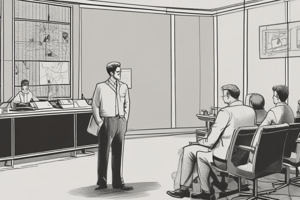Podcast
Questions and Answers
What was the primary aim of Milgram's research?
What was the primary aim of Milgram's research?
- To investigate the impact of physical punishment
- To understand obedience in the absence of any threat (correct)
- To explore the psychological effects of war on participants
- To study memory recall under pressure
In Milgram's experiment, what was the role of the stooge who acted as the learner?
In Milgram's experiment, what was the role of the stooge who acted as the learner?
- To actually learn and provide accurate feedback
- To encourage the teacher to administer more shocks
- To help strap the teacher into the chair
- To feign pain in response to electric shocks (correct)
Which factor significantly decreased obedience in Milgram's variations?
Which factor significantly decreased obedience in Milgram's variations?
- The presence of other teachers administering shocks
- The teacher's physical distance from the learner
- The authority figure issuing orders over the telephone (correct)
- The moral background of the teacher
Which of the following observations about participants in Milgram's study was supported by the results?
Which of the following observations about participants in Milgram's study was supported by the results?
What can be inferred about the 'agentic state' in Milgram's research?
What can be inferred about the 'agentic state' in Milgram's research?
What factor significantly reduced conformity in Milgram's experiments?
What factor significantly reduced conformity in Milgram's experiments?
According to Reicher, Haslam & Smith, what is the nature of the obedience observed in Milgram's studies?
According to Reicher, Haslam & Smith, what is the nature of the obedience observed in Milgram's studies?
What is the main conclusion from Sherif's 1935 study on group norms?
What is the main conclusion from Sherif's 1935 study on group norms?
According to Asch's study, what percentage of subjects did not make any errors when judging line lengths?
According to Asch's study, what percentage of subjects did not make any errors when judging line lengths?
What percentage of participants in Burger's study stopped at or before 150 volts?
What percentage of participants in Burger's study stopped at or before 150 volts?
Which ethical concern was raised regarding Milgram's original experiment?
Which ethical concern was raised regarding Milgram's original experiment?
Which of the following concepts was highlighted by Deutsch and Gerrard's dual process theory?
Which of the following concepts was highlighted by Deutsch and Gerrard's dual process theory?
What was the primary reason for Milgram’s use of deception in his experiments?
What was the primary reason for Milgram’s use of deception in his experiments?
What role does group identity play according to contemporary research discussed?
What role does group identity play according to contemporary research discussed?
In Gonzalez-Franco et al.'s study, what effect did the presence of a 'learner' have on participants?
In Gonzalez-Franco et al.'s study, what effect did the presence of a 'learner' have on participants?
What impact does reassurance from an in-group member have on an individual's anxiety during the icy water experiment?
What impact does reassurance from an in-group member have on an individual's anxiety during the icy water experiment?
What was the main finding of Platow et al's 2005 research regarding laughter in social contexts?
What was the main finding of Platow et al's 2005 research regarding laughter in social contexts?
What conclusion did Burger draw regarding the replication of Milgram's study?
What conclusion did Burger draw regarding the replication of Milgram's study?
What does 'engaged followership' imply in the context of obedience and authority?
What does 'engaged followership' imply in the context of obedience and authority?
How did Allport's view of groups differ from traditional perspectives?
How did Allport's view of groups differ from traditional perspectives?
Flashcards
Milgram's Obedience Study
Milgram's Obedience Study
A psychological experiment investigating the willingness of participants to obey an authority figure's instructions, even when those instructions conflict with their personal conscience.
Agentic state
Agentic state
A mental state where a person sees themselves as an agent of an authority figure, thus feeling less personally responsible for their actions.
Obedience to authority
Obedience to authority
Compliance with the demands of an authority figure, even if it goes against personal values.
Experimental Variations in Milgram's Study
Experimental Variations in Milgram's Study
Signup and view all the flashcards
High Obedience in Milgram's Experiment
High Obedience in Milgram's Experiment
Signup and view all the flashcards
Social Norm
Social Norm
Signup and view all the flashcards
Conformity
Conformity
Signup and view all the flashcards
Information Influence
Information Influence
Signup and view all the flashcards
Normative Influence
Normative Influence
Signup and view all the flashcards
Autokinetic Effect
Autokinetic Effect
Signup and view all the flashcards
Reference Groups
Reference Groups
Signup and view all the flashcards
In-group Bias
In-group Bias
Signup and view all the flashcards
Milgram's Experiment
Milgram's Experiment
Signup and view all the flashcards
Social Beliefs and Legitimacy
Social Beliefs and Legitimacy
Signup and view all the flashcards
Gradual Increments in Obedience
Gradual Increments in Obedience
Signup and view all the flashcards
Experimenters' Arguments: Reduce Conformity
Experimenters' Arguments: Reduce Conformity
Signup and view all the flashcards
Feeling of Uncertainty: Asking Others
Feeling of Uncertainty: Asking Others
Signup and view all the flashcards
Engaged Followership
Engaged Followership
Signup and view all the flashcards
Virtuous vs. Vicious Tasks
Virtuous vs. Vicious Tasks
Signup and view all the flashcards
Ethical Considerations in Milgram's Experiment
Ethical Considerations in Milgram's Experiment
Signup and view all the flashcards
Study Notes
Milgram's Obedience Studies
- Influences: Milgram's study was influenced by events like the My Lai massacre and the Vietnam War, as well as the actions of Adolf Eichmann.
- Aim: To study obedience, specifically, willingness to obey authority figures without threat, solely based on the authority's claim to control.
- Procedure: Participants were recruited for a study on learning and memory. They were assigned the role of "teacher" (always the real participant) or "learner" (a stooge). Teachers were instructed to administer electric shocks to the learner for incorrect answers, with progressively higher voltages. A sample shock (45 volts) was given to the teacher. The experimenter encouraged the teachers to continue despite the learner's distress.
Experimental Variations
- Proximity of Learner: Changing the learner's proximity had a significant impact on obedience rates.
- Hearing the learner's cries or complaints increased disobedience.
- Being in the same room or having to physically force the learner's hand onto the shock plate decreased obedience.
- Proximity of Authority Figure: Giving instructions over the phone significantly reduced obedience (21%).
- Location: Experiments conducted in different locations (e.g., a different building) had varying effects on obedience rates.
Results and Interpretations
- Overall obedience: 62.5% of participants administered the highest shock level.
- Average maximum shock: 368 volts.
- Variations in outcomes based on context.
- Observational findings: Participants often showed stress or discomfort but continued with the task. This suggests obedience was not driven by sadistic personalities. Some subjects stopped without being asked to stop (2/40).
- Explanation 1: Unthinking obedience:
- Participants were absorbed in the procedure and might not have considered the learner's suffering.
- Participants viewed themselves as agents of the experimenter, disassociating from personal responsibility.
- Explanation 2: Critical analysis of context:
- Obedience is related to a participant's understanding of their role and the context.
- Gradual escalation of shock levels played a significant role.
- An experimenter's authority and credibility are key in fostering an individual's commitment.
- If a scheme, such as someone other than the experimenter suggesting an increased voltage was presented, the obedience rate decreased to 20%. This indicates that the perceived legitimacy of authority was essential.
- Milgram's Personal Reflection: Milgram aimed to study the conditions in which people obey authority, even when it goes against their conscience.
Reicher, Haslam & Smith (2012)
- Alternative perspective: Obedience is not solely "unthinking" obedience but rather an active identification with the experimenter's objectives. Participants positively identify with the task.
- "Engaged follower-ship": Obedience depends on the experimenter convincing participants they contributed to a positive enterprise.
Ethical Considerations
- Informed consent: Participant awareness of the true experiment.
- Right to withdraw: Participants' ability to leave the experiment.
- Potential harm: Participants could experience anxiety or emotional distress.
- Burger's Replication (2009): Replicated Milgram's study up to 150 volts due to ethical concerns. Observed a substantial obedience difference past 150 volts compared to Milgram.
- Virtual Reality (VR): Slater et al (2006) used VR to establish a sense of realism without physical harm.
- Gonzalez-Franco et al (2018): Used VR to measure participants' focus on getting the "right answers" in response to a learner's needs. Found an increased focus on providing correct answers during the VR experiment compared to the standard experiment without a learner.
Criticisms
- Lab research: concerns about generalizability to real-world situations
- Deception: Ethical concerns regarding deceiving participants about the nature of the study
- Ecological validity: Participants may alter behaviours due to being observed.
Hofling et al (1966)
- Field experiment in a hospital: Nurses were "ordered" to administer an excessive dose of a drug by an unseen doctor. A majority of nurses followed the orders despite policies forbidding exceeding a maximum dose.
- Implications: Highlighting the influence of authority figures in real-world scenarios, supporting Milgram.
Correlation
- Correlation: Relationships between factors in an experiment.
Allport (1924)
- Individual approach: Treated groups as a convenient abstraction/an aggregated sum of individuals (behaviorism).
- Missing social norms: Ignores the impact of socially shared understandings on behaviour.
Sherif (1935)
- Conformity and norms: Studied how individuals' judgments evolved into group norms with the autokinetic effect.
- Participants initial estimates converged in group settings (informational influence).
- These group norms persisted even when participants were alone (internalization).
- Informational influence: Conformity due to the desire for valid information.
Asch
- Conformity study: Showed how people conform to the perceived judgment of a group even when the group's judgment is objectively incorrect.
- participants provided answers regarding line lengths after hearing the responses of actors (conformity).
Deutsch and Gerrard (1955)
- Dual Process Theory: Explains both Sherif and Asch's results.
- Informational Influence: Conformity driven by need for valid information (Sherif).
- Normative Influence: Conformity arising from the desire to avoid social rejection/punishment (Asch).
Contemporary Research
- Turner (1991) and Identity: Groups shape self-perception. Trust in group members contributes to conformity.
- Platow et al (2005): Studied laughter and pain reactions to show how our reactions are impacted by identifying with the group. Reassurance from in-group members reduces discomfort/anxiety levels.
Conclusions
- Diverse Processes: Group dynamics are complex and influenced by various pressures and social norms.
- Social Influence: Explained by group influence on individuals through shared expectations.
- Contemporary Research: Contemporary research focuses on the role of group identification in determining the effect of others/groups on an individual's behaviour.
- Uncertainty in social behaviour: Conformity arises from uncertainty regarding reality, requiring reliance on information from others.
- Private vs. Public Compliance: Conformity motivated by liking/acceptance (desire to belong).
Studying That Suits You
Use AI to generate personalized quizzes and flashcards to suit your learning preferences.




